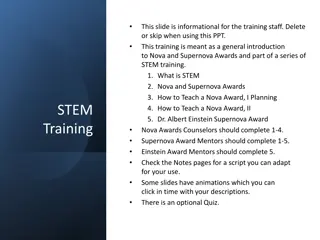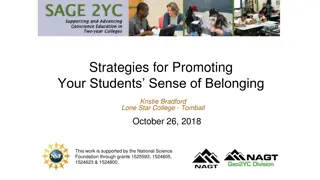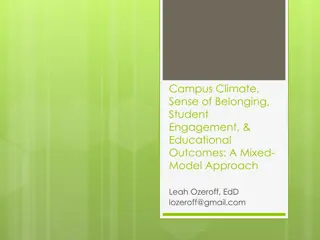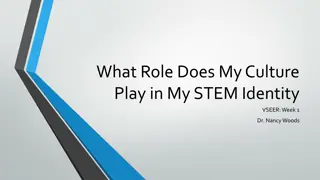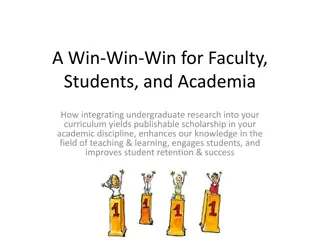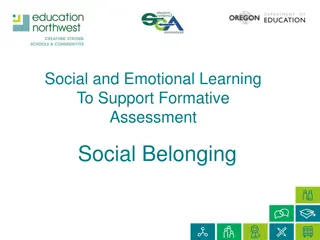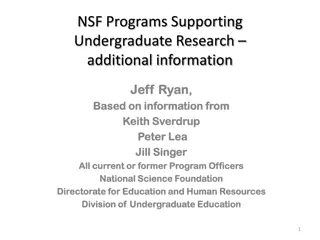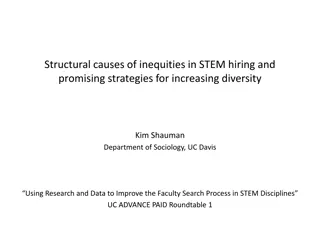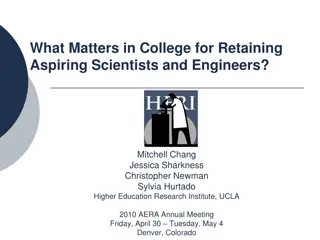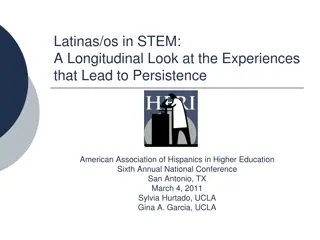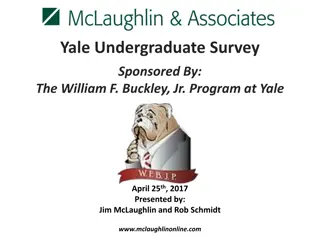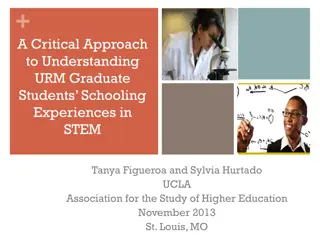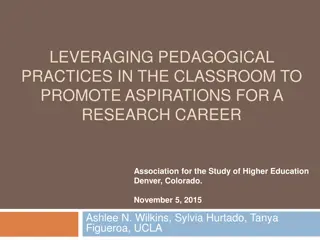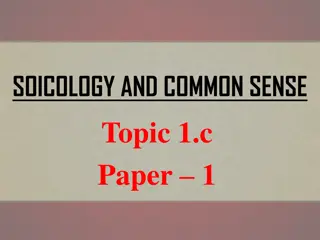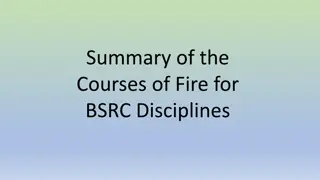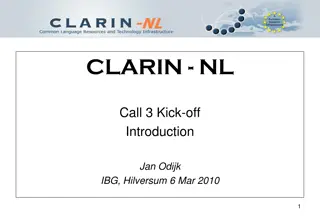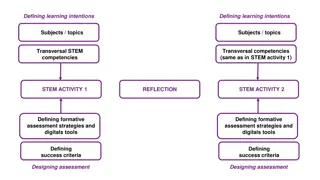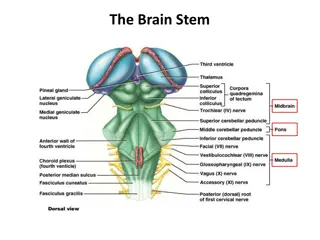Factors Affecting Undergraduate Students' Sense of Belonging in STEM Disciplines
Student attrition in STEM fields remains a critical issue, with women and underrepresented minority students facing higher dropout rates. Sense of belonging is identified as a key factor influencing retention, particularly for female and URM students. This study explores various aspects, including research experience, classroom dynamics, and student values, that may impact students' sense of belonging in STEM disciplines. The research background highlights data collection efforts since 2011, with a recent focus on expanding surveys and interviews to assess sense of belonging and learning outcomes.
Download Presentation

Please find below an Image/Link to download the presentation.
The content on the website is provided AS IS for your information and personal use only. It may not be sold, licensed, or shared on other websites without obtaining consent from the author. Download presentation by click this link. If you encounter any issues during the download, it is possible that the publisher has removed the file from their server.
E N D
Presentation Transcript
Factors Associated with Undergraduate Students' Sense of Belonging in STEM Disciplines Gili Marbach-Ad, Sara Gliese, Kaci Thompson Director of Teaching and Learning Center College of Computer, Mathematical and Natural Sciences University of Maryland
Rationale Student attrition is a serious concern in STEM, with less than 50% of students who enter higher education actually completing a degree In particular, women and underrepresented minority students (URM) are 1.5-2x more likely to switch out of STEM majors One factor linked to student attrition is sense of belonging Sense of belonging is a broad construct measured a variety of ways For female and URM students, sense of belonging has been found to be much more closely tied to their level of personal interest in STEM Rainey, K., Dancy, M., Mickelson, R., Stearns, E., & Moller, S. (2018). Race and gender differences in how sense of belonging influences decisions to major in STEM. International journal of STEM education, 5(1), 1-14. Seymour, E., & Hunter, A. (2019). Talking about Leaving Revisited. Retrieved April 29, 2022, from https://doi.org/10.1007/978-3-030-25304-2 Witherspoon, E. B., & Schunn, C. D. (2020). Locating and understanding the largest gender differences in pathways to science degrees. Science Education, 104(2), 144-163.
Rationale Additional factors that may be associated with attrition and sense of belonging include: Research experience Classroom experiences Student values STEM is a broad field containing many disciplines, and it is important to consider whether belonging, individual factors, and their interaction may differ between disciplines Lavi, R., Tal, M., & Dori, Y. J. (2021). Perceptions of STEM alumni and students on developing 21st century skills through methods of teaching and learning. Studies in Educational Evaluation, 70, 101002. Marbach-Ad, G., Hunt, C., & Thompson, K. V. (2019). Exploring the values undergraduate students attribute to cross-disciplinary skills needed for the workplace: An analysis of five STEM disciplines. Journal of Science Education and Technology, 28, 452-469. Marbach-Ad, G., Rietschel, C., & Thompson, K. V. (2016). Validation and application of the survey of teaching beliefs and practices for undergraduates (STEP-U): Identifying factors associated with valuing important workplace skills among biology students. CBE Life Sciences Education, 15(4), ar59.
Research Background Since 2011: Data collection from seniors about their reported values and experiences (STEP-U) 2015-2016: Start conducting individual student interviews; Presenting data in faculty meetings Since 2018: Expansion of data collection to three other universities Since 2020: Expansion of items on survey and interviews to Sense of Belonging and Learning Outcome assessment. Survey of Teaching Beliefs and Practices for Undergraduates (STEP-U) Wheeler, et al. (2023). Factors predicting the extent to which STEM students value cross-disciplinary skills: A study across four institutions. CBE-Life Science Education, 22.2: ar20.
Factors Representing Students Values Rate the following skills in terms of importance to you in your undergraduate education. The word discipline, used below, refers to your major field of study (e.g., chemistry, biology, mathematics). From 1 (Not Important) to 5 (Extremely Important)
Factors Representing Class Experiences In the undergraduate courses for your major (that is, taught by CMNS faculty), how often did instructors use these methods? From 1 to 5 (Never; About half of my courses; In all of my courses)
Research Questions For this study, the main objective is to examine whether there are differences between disciplines in factors that are linked to student sense of belonging. 1. What are the similarities and differences, between disciplines, in the factors (student values, experiences, and characteristics) that are linked to student sense of belonging? 2. What themes exist in student interview responses about sense of belonging, and how do these align with and expand upon quantitative findings to inform future research questions?
Methods - Quantitative Data Data for this study were collected in Spring 2021 and 2022 from graduating CMNS students through an online exit survey Exit survey Questions regarding their demographics, research experience, and post graduation plans STEP-U measure (54 items) Values (4 factors) Experiences (2 factors) Sense of Belonging measure (5 items) STEP-U=Survey of teaching beliefs and practices for undergraduates
Participants A total of 1208 students across 10 majors responded; for analysis purposes only majors with more than 30 respondents were used (N = 1130) Biological Sciences Computer Science Math Physics Chemistry Student numbers 427(45%) 515(46%) 107(27%) 52(39%) 31(41%) Gender (female) 70% 20% 37% 25% 71% URM a 17% 9% 11% 4% 3% Transfer student b 16% 14% 23% 15% 6% Cumulative GPA 3.63 3.47 3.48 3.66 3.54 Research experience c 64% 30% 33% 73% 87%
Sense of Belonging to Your Discipline 1. In general, my interest in biology is an important part of my self-image. 2. My interest in biology is an important reflection of who I am. 3. I feel like I belong in the field of biology. 4. I have a strong sense of belonging to the community of biologists. 5. I am a biologist. Estrada, M., Woodcock, A., Hernandez, P. R., & Schultz, P. (2011). Toward a model of social influence that explains minority student integration into the scientific community. Journal of Educational Psychology, 103(1), 206 222.10.1037/a0020743
Results - Quantitative Analysis 1= Strongly disagree .. 5= Strongly agree Standard Deviations of Total Sense of Belonging Score: Biology: .87 Mathematics: .85 Chemistry: .80 Computer Science: .91 Physics: .85
Quantitative Data Analysis The quantitative data were analyzed using SPSS version 28.0 Data were check for regression assumptions Heteroskedasticity-consistent error estimators (HC3) were used to address heteroskedasticity concerns (RLM Macro Darlington & Hayes & Hayes, 2017) Multiple linear regressions were conducted
Results Regression Analysis Biology Predictor b p Values Factor: Nature of STEM Disciplines 0.28** 0.001 Values Factor: Process Skills and Reasoning 0.26* 0.02 Transfer Status 0.25* 0.04 Plans to Change Field After Graduating -0.65* 0.02 GPA 0.31* 0.02 (F (5, 418) = 12.16, p < .001, R2= .14)
Results Regression Analysis Computer Science Predictor b p Experiences Factor: Interactive/Evidence-Based 0.26** 0.003 Values Factor: Process Skills and Reasoning 0.33*** <.001 Values Factor: Nature of STEM Disciplines 0.19** 0.004 Gender (Female) -0.30*** <.001 Research Experience 0.22* 0.01 Plans to Change Field After Graduating -1.46*** <.001 (F (6, 498) = 23.44, p < .001, R2= .21)
Results Regression Analysis Predictor b p Mathematics Experiences Factor: Interactive/Evidence-Based 0.30* 0.01 GPA 0.41* 0.03 Physics Experiences Factor: Interactive/Evidence-Based 0.49* 0.03 Research Experience 0.77** 0.004 Chemistry Values Factor: Research and Writing 0.63* 0.02 (F (2, 97) = 6.01, p < .01, R2= .09) (F (2, 49) = 7.88, p < .01, R2= .24) (F (1, 29) = 5.69, p < .05, R2= .14) Mathematics: Physics: Chemistry:
Methods - Qualitative Data Sixteen students were interviewed to expand upon students responses on the survey Students completed the sense of belonging measure Then students participated in a 10-15 minute interview of follow-up questions to their measure responses The qualitative interview data were analyzed using Dedoose Research team members engaged in a collaborative coding process for each interview transcript
Results Qualitative Analysis Four themes emerged from the interviews: Definitions Positive influences Negative influences Previous Experiences/Upbringing
Category 1: Definitions Self-Image/Reflection Students often struggled with how to define these constructs and how to rate them differently Community Vs. Field Community was viewed as the people around them; Field was viewed as how their personal interest aligned with the broader field I am (e.g., a Biologist); What does it means to be a 75% of students referenced the importance of participating in research 55% of students referenced needing further education (i.e., graduate school) Having interest/Passion ( I think somebody who's a mathematician, like eats, breathes, and sleeps math, and I don't think I do that. )
Category 2: Positive Influences University Communities Living-Learning Programs, Honors Colleges, Fraternities/Sororities, Peer Mentoring Programs, etc. Smaller departments/majors made it easier to connect with peers and faculty Talking the Same Language If I had a conversation with someone about it that was similar to me, then I feel like I could relate to them. Time and Greater Experiences I feel like it's probably solidified over time. Yeah, because I've had more experience in it and I've, you know, seen that I still like it, and I still enjoy learning the material and pursuing experiences in it.
Category 3: Negative Influences Large Departments/Majors/Courses 50% of students talked about size of their department impacting belonging I feel like there should be a little more department involvement to make the biggest major on campus feel a little smaller. Imposter Syndrome 25% students referenced imposter syndrome I suffer from imposter syndrome, so I constantly basically feel like an idiot who doesn't know what they're doing. Weed-Out Courses A few students referenced weed-out culture Most of my classes were weed out classes. And it's kind of like, if you don't do well in this course, then you're just not fit to be a doctor or like you're not fit for your future.
Category 4: Previous Experiences/Upbringing Pre-University Experiences In high school I always really liked math. That was my favorite subject I really connected with my math teachers and then I kind of didn't really know like what area I wanted to focus in when I was applying for majors. And I just liked math, so I applied to the mathematics major. Parental Expectations I do think a big part of it is like, you kind of have to have the personal drive, which I was fortunate enough to grow up with. I've always kind of been taught to do well, if that makes sense. Like if I didn't do well my parents were unhappy with me, I kind of just learned that I needed to do well.
Summary From quantitative analysis we found that predictors of sense of belonging did differ from major to major. Qualitative interview data shed light on how students understood the sense of belonging questions, and what at the university and outside the university specifically impacted their belonging, positively or negatively, such as university communities, weed- out courses, and past experiences. Future Directions Collect data from earlier years (Freshman, sophomore, junior). Use the data for professional development. Collect data regarding other diversity, equity, inclusion, justice, and accessibility-related factors.






